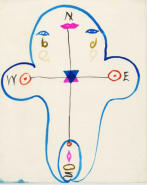



All texts copyright Richard Shillitoe
homunculus 1
1940
Watercolour.
8 x 9¼in. (20.3 x 24cm.)
Inscribed verso: ‘Alchemical Figure’ plus the title and 1940.
Provenance
NT then TGA.
The word ‘homunculus’ is from the Latin, meaning ‘little man’. It is a familiar
concept in alchemy and modern science. Alchemically, it refers to a being
created in a retort by the mage, usually from his own body fluids. It is,
therefore, a metaphor for the magician’s spiritual development. Scientifically, it generally refers to a
pictorial illustration that demonstrates the area of the cortex given to sensory or motor perception.
Hence, hands, lips genitals, etc. all appear to be dis-proportionately large.
There are at least six watercolours that feature the homunculus. They all share a close family
resemblance. In them, Colquhoun has given special emphasis to those body parts that were of special
significance to her. Thus, she has reduced the body to its openings; those apertures which, for example,
signify the route of entry of the deity’s beneficence or which establish occult connections with the Earth’s
subterranean chthonic forces.
In the present example, within the quatrefoil shape of the simplified body, and reading down from the top
of the head, the apertures depicted are: the eyes; the nostrils; the mouth; the nipples; the urethra,
vagina and anus. The figure is, therefore, to be read as female.
Colquhoun also included within the body-form a number of hermetic symbols. The body itself, as is the
case in the majority of the Homunculus series is strikingly similar to the crucifix mounted on a plaque that
hangs on the wall above the Virgin’s head in Death of the Virgin (1931). The same outline also occurs in
Christian marriage figure (1942). It is both a crucifix with rounded extremities and an immature body
with budding limbs. The outline of the homunculus, therefore, suggests birth, growth, death and
resurrection. At the heart of the figure (this location is to be understood metaphorically as well as
spatially), overlapping blue and red triangles symbolise the unification of the genders, and the worlds of
nature and spirit.
North-South and East-West axes indicate the cardinal points. Each is marked N, E, S and W as appropriate.
The presence of such clearly depicted axes emphasises the presence of the crucifix. The E-W axis
terminates at each end with a dotted circle, a symbol that occurs in several of the Christian Marriage
paintings, usually in association with the ‘crossed lips’ motif that suggests the conjunction of the genders.
The dotted circle indicates the nipples, but it is also a common magical symbol. It indicated eternity to
the Pythagoreans, Kether to Golden Dawn magicians, and for the magicians of the OTO, it became a solar
phallus.
The watercolours of the Homunculus series are to be understood as the alchemical metamorphosis of
gendered individuals and the birth of a unified, integrated, being.


















